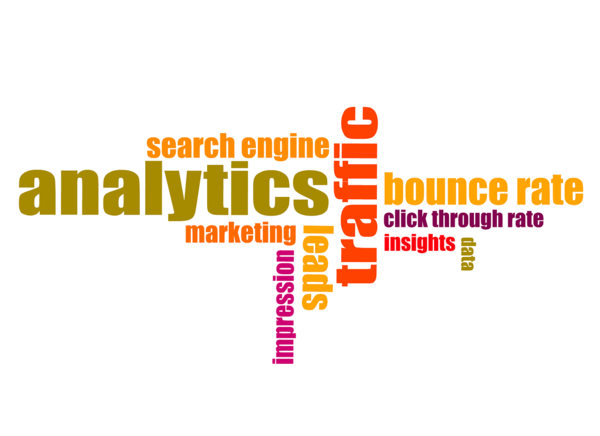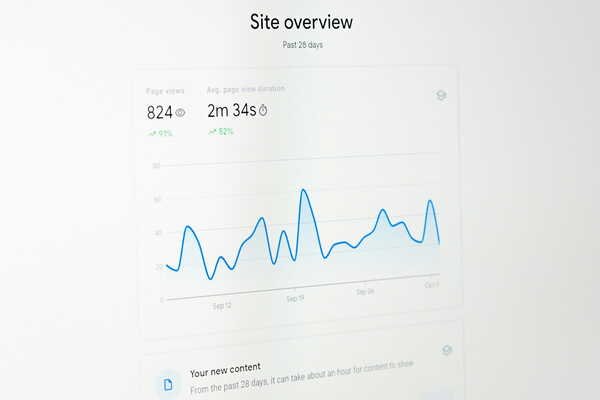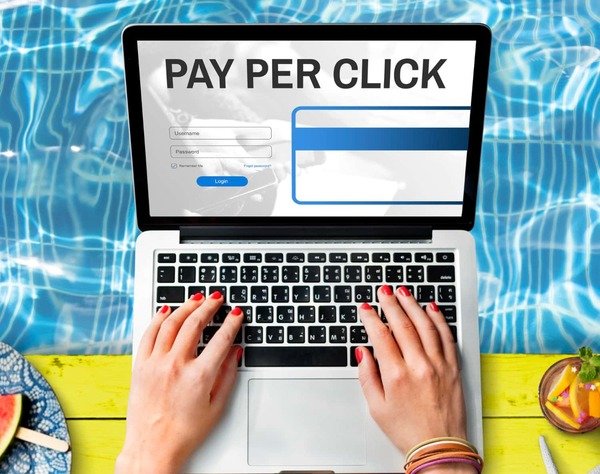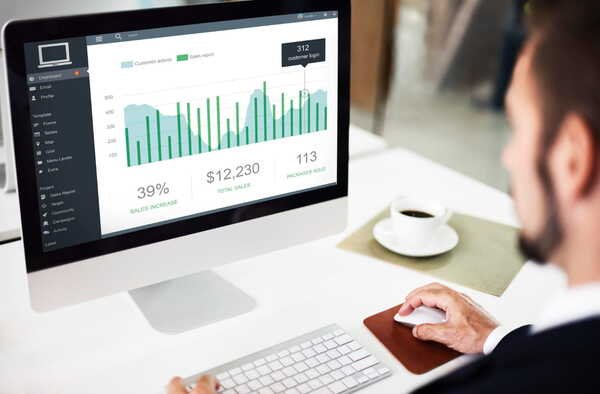Google Ads Metrics That Matter: What They Tell You
The key Google Ads metrics that truly matter are click-through rate (CTR), conversion rate, cost per acquisition (CPA), impression share, and Quality Score. Each of these metrics reveals a crucial aspect of your campaign’s health. A high CTR shows your ads grab attention (an early sign of ad health), while conversion rate tells you if those clicks turn into real business results. CPA measures how cost-effective those conversions are – balancing your spend with outcomes. Impression share lets you know how often your ads appear relative to how often they could appear (highlighting missed opportunities). And Quality Score is Google’s own relevance score for your ads and landing pages, influencing your costs and visibility. By understanding what each metric tells you, you can refine your Google Ads strategy for maximum ROI.
Imagine two businesses running the same ad. Business A gets plenty of clicks but few sales, whereas Business B gets fewer clicks but more customers. We’ve seen scenarios like this at Eclipse Marketing. As a leading Denver SEO agency, we know the difference comes down to focusing on the right metrics. In one case, a client was excited by a high number of clicks (great CTR) but couldn’t figure out why sales were flat. The missing piece? Conversion rate – those clicks weren’t converting into buyers because the landing page was weak. Once we identified that issue and improved the page (plus the offer), the conversion rate jumped and the campaign became profitable. This anecdote shows that not all Google Ads numbers are equal; some are mere vanity metrics while others are actionable indicators of success.
This article supports our Google Ads Strategy: A Complete Guide for Maximum ROI in 2025 by zooming in on the metrics that matter most and explaining what each one tells you. We’ll break down five essential metrics – CTR, conversion rate, CPA, impression share, and Quality Score – and show how they go from problem to solution to proof of success. Tracking these metrics closely is a cornerstone of any effective Google Ads approach (and something our Google Ads specialists do daily). Let’s dive into each metric and see why it matters.

Click-Through Rate (CTR): Why It’s the First Sign of Ad Health
Click-through rate, or CTR, measures the percentage of people who clicked your ad after seeing it. It’s calculated simply as clicks ÷ impressions × 100%. For example, if your ad was shown 1,000 times and got 50 clicks, the CTR is 5%. CTR is often the first sign of ad health because it indicates whether your ad is catching people’s attention and resonating with them. If lots of users who see the ad decide to click, that’s a strong vote of confidence in your ad’s relevance and appeal.
A high CTR tells you that your ad copy, headline, and overall message are effectively grabbing your target audience’s interest. It means your keywords, ad text, and maybe even visuals (for display ads) are well-aligned with what users are searching for. In other words, people find your ad compelling enough to act on it. This is critical, especially in search campaigns – if nobody clicks your ads, you have no chance to convert them later. In fact, the average click-through rate on Google search is only about 3.17% across industries (and even lower on display networks), so anything significantly above that suggests your ad is doing something right. On the flip side, a low CTR is a warning sign. It suggests that your ad isn’t appealing or relevant enough to the audience. Perhaps the ad copy is uninteresting, the offer is weak, or you’re targeting the wrong keywords. A poor CTR means you’re missing out on potential visitors and customers – your ad showed up, but most people shrugged and scrolled past it.
CTR isn’t just a vanity number; it has practical implications for your campaign. Google uses CTR as an important factor in calculating your Quality Score (more on that later). A strong CTR signals to Google that users find your ad useful, which can boost your Quality Score and lower your cost per click over time. However, it’s important to remember that CTR by itself doesn’t guarantee success – it’s the first piece of the puzzle. For example, an ad with a fantastic CTR but no conversions is like a store that everyone visits but no one buys from. So, view CTR as the first health check. If it’s low, your immediate “problem” is that your ad isn’t attracting interest. The solution might be to rewrite your ad headlines, include a clearer call-to-action, or ensure your keywords match the ad’s message. You could also add ad extensions (like sitelinks or callouts) to give users more reasons to click. Once you implement these changes, watch for proof of improvement – a rising CTR will tell you your ad is now on the right track. But then you must also follow through to see what happens after the click, which brings us to conversion rate.

Conversion Rate: Tracking What Truly Matters
If CTR is about grabbing attention, conversion rate is about delivering results. Conversion rate measures the percentage of clicks that turn into a desired action, such as a purchase, sign-up, lead form submission, or any goal you’ve set. It’s calculated as conversions ÷ clicks × 100%. For example, if 100 people clicked your ad and 5 of them made a purchase, your conversion rate is 5%. This metric is often considered the true measure of success for a campaign, because it reflects how effectively your Google Ads traffic is accomplishing your business objectives.
Why does conversion rate matter so much? Think back to Business A and B from our earlier scenario: Business A had a high CTR but low conversion – lots of interest, but little follow-through. Business B had a moderate CTR but a higher conversion rate – fewer clicks, but those clicks counted. Conversions are ultimately what keep the lights on. As one marketing saying goes, “Impressions and clicks don’t pay the bills – conversions do.” A high conversion rate tells you that your ads are not only attracting visitors, but that your landing page, offer, and user experience are convincing those visitors to take the next step. In essence, it shows that you’re targeting the right audience with the right message, and when people arrive on your site, they find what they were promised and are motivated to act. The average conversion rate on Google Ads is around 4-5% for search campaigns, meaning only about 4 out of 100 ad clicks turn into conversions on average. If you’re getting much more than that, it’s a strong indicator that you’re hitting the mark with your campaign. If it’s lower, there’s room to improve.
A low conversion rate is a sign of a disconnect in your funnel. It can signal several problems (or a mix of them): perhaps your landing page isn’t relevant to the ad, maybe it’s slow or confusing to navigate, or your offer isn’t compelling enough. It could also indicate that you’re attracting the wrong traffic – people click out of curiosity or misled expectations, but they weren’t really looking for what you sell. Identifying this as the problem is key. The solution lies in optimization. Start by ensuring message match: the text in your ad should line up with what users see on the landing page. If your ad promises “50% off web design services,” the page must prominently feature that offer (and yes, having a well-designed landing page is crucial – good web design can make or break conversions). You might need to simplify your conversion process as well: for instance, use a shorter form, or make your “Buy Now” button more visible. Sometimes, the fix is targeting – refining keywords or audience settings so that the people clicking are genuinely interested in what you offer.
Testing is your friend here. Try A/B testing different headlines, images, or calls-to-action. Perhaps one version of your landing page has a clearer value proposition that boosts conversions. Also consider adding trust signals (like customer testimonials, security badges, or money-back guarantees) to reassure users who arrive. When you implement these changes, look for proof in the numbers: an increasing conversion rate will tell you that you’re on the right track, turning more clicks into customers. And remember, improving conversion rate doesn’t just bump up your sales – it also makes your ad spend more efficient, which directly ties into the next metric: cost per acquisition.

Cost Per Acquisition (CPA): The Balance Between Spend and Results
Cost per acquisition (CPA), also known as cost per conversion, tells you how much money you spend to get one conversion. In simple terms, it’s your total ad spend divided by the number of conversions. If you spent $500 on Google Ads this week and got 25 conversions (say, 25 sign-ups or sales), your CPA is $20. This metric is all about cost-effectiveness. It answers the question: “How much did that lead or sale cost me?” and by extension, “Is my campaign profitable?”
CPA is crucial because it ties your ad performance directly to financial outcomes. A campaign might have a great CTR and a decent conversion rate, but if the cost per conversion is too high, the campaign might not be sustainable. For instance, spending $50 in ads to sell a $20 product is clearly a losing proposition. Finding the right balance is the key. You want a CPA that fits within your profit margins or customer lifetime value. Many advertisers set CPA targets (for example, “I need a CPA of $10 or less to stay profitable”), and optimizing the campaign often means driving that number down.
What can cause a high CPA (problem) and how do we solve it? A high CPA means you’re paying too much for each conversion. This could be due to a low conversion rate (needing many clicks to get one sale) or high costs per click – or both. One common cause is broad targeting: if your ads are shown to people who aren’t likely to convert, you waste budget on unqualified clicks. Another cause can be heavy competition on keywords driving bids up, which increases your costs. To bring CPA into a healthy range, you have several solutions:
- Refine your targeting: Show your ads in front of people more likely to convert. This might mean using more specific keywords, leveraging audience targeting, or excluding irrelevant searches. By honing in on the right crowd, you reduce wasted spend on people who won’t convert, thereby lowering CPA.
- Optimize your ads and landing pages: This ties back to conversion rate. If you improve your conversion rate, your CPA will naturally drop, since more of your clicks turn into conversions. Ensuring a smooth user experience – from ad to landing page to checkout – can significantly boost conversion rates and reduce CPA.
- Adjust bidding strategies: Google Ads offers smart bidding options like Target CPA bidding. These advanced bidding strategies (discussed more in our Advanced Bidding Strategies for Google Ads in 2025 article) use Google’s AI to automatically set bids to help you get as many conversions as possible at your target CPA. For example, if you tell Google you want a $10 CPA, it will try to bid higher or lower in each auction to hit that goal. This can be a powerful way to control costs, though it works best once you have sufficient conversion data.
- Monitor and optimize costs: Sometimes lowering CPA means lowering your average cost per click. You might do this by improving Quality Score (which can lower click costs) or by shifting budget to less expensive keywords that still convert well. You can also add negative keywords to avoid paying for clicks that are unlikely to convert (for example, if you sell premium software, you’d exclude searches including “free software”).
The proof of success here is straightforward: watch your CPA trend over time. If it’s dropping and getting closer to (or under) your target, you’re moving in the right direction. For instance, say you started with a CPA of $50 and through various optimizations you brought it down to $30, then $20 – that shows your campaign is becoming much more cost-efficient. Keep in mind that a “good” CPA is relative – it depends on how much a conversion is worth to you. A $100 CPA might be fantastic if you’re selling a $2,000 service, but terrible if you’re selling a $15 gadget. The ultimate aim is maximizing ROI: getting conversions at a cost that makes sense for your business. CPA is the metric that keeps you honest about that balance between spend and results, ensuring you’re not paying $10 in ads to earn $5 in revenue.

Impression Share: Seeing the Whole Playing Field
Impression share is a bit different from the other metrics we’ve covered – it’s not about the success of individual clicks or conversions, but about your share of the market’s visibility. Impression share is defined as the percentage of impressions your ads received out of the total impressions they were eligible to receive. In other words, it answers the question: “Out of all the times Google could have shown my ad, how often did it actually show up?” If your impression share is 50%, that means your ad was shown in only half of the opportunities available. If it’s 90%, you captured most of the possible impressions in your target market.
This metric helps you see the whole playing field. You might be getting some clicks and conversions, but impression share reveals the scale of what you might be missing. A low impression share indicates that there were many searches or display opportunities where your ads didn’t appear. Why does that happen? The two main culprits are budget and ad rank. If your daily budget is too low, Google might hold back your ad once the budget is spent, causing you to miss impressions – this shows up as “Impression share lost (budget)”. If your ad rank (which depends on your bid and Quality Score) isn’t high enough, your ad might not win the auction for a lot of searches – this appears as “Impression share lost (rank)”. Essentially, impression share tells you how much room you have to grow. For example, if you see an impression share of 30%, it means 70% of the time your ads weren’t showing when they could have. That’s a huge missed opportunity, equivalent to a store being closed for most of the day. On the other hand, if you have an impression share of, say, 95%, you’re pretty much maxing out your presence for your current targeting settings.
Why does impression share matter? Because even if your current results are good, you might be leaving money on the table by not appearing more often. Let’s say your ads convert well when they run, but you only have 50% impression share due to budget limits. By increasing your budget (and thus impression share), you could double your conversions – because you’d show up in twice as many relevant searches. Similarly, if low ad rank is holding back your impression share, improving your Quality Score or bids could significantly increase your reach without changing anything else about your ads or landing pages. In short, impression share is about coverage: how much of the potential audience you’re actually reaching. It’s like a TV ad that airs in 5 out of 10 slots instead of all 10 – impression share measures those 5/10 slots.
If you identify low impression share as a problem, the solution depends on the cause:
- If it’s budget, the obvious fix is to raise your budget (if your campaigns are profitable and you can afford to scale up). Even a modest budget increase can capture more impressions and thus more clicks. Google Ads actually provides metrics telling you the percentage of impressions lost to budget and to rank, respectively, which helps pinpoint the issue.
- If it’s rank, then you might need to either increase your bids or improve your Quality Score (or both). Improving Quality Score (by making ads and landing pages more relevant) gives you a twofer – it not only can improve impression share by winning more auctions, but also lowers your cost per click. You could also refine your targeting to focus on more specific keywords or times of day, etc., where you can more easily dominate impressions.
- Another solution is using Google’s Target Impression Share bidding. This automated bid strategy lets you tell Google you want, say, 90% impression share at the top of the page. Google will then adjust bids to try to achieve that coverage. This can be useful for brand awareness campaigns where being present most of the time is important.
The proof of success when addressing impression share is straightforward: your impression share percentage will rise. If you boost budget and see impression share climb from 50% to 80%, you know you’re reaching a lot more of your potential audience than before. That can directly lead to more clicks and conversions (provided those additional impressions are still relevant traffic). One word of caution: impression share doesn’t measure quality, so don’t chase 100% impression share on a broad, untargeted campaign – you might end up showing to lots of people who aren’t a good fit, wasting money. Use impression share as a strategic metric: it shows the scale of opportunity. Once your campaign is finely tuned and profitable, increasing impression share is how you scale up your results. It’s seeing the whole playing field and deciding to play in more of it.

Quality Score: Google’s Scorecard on Your Ad Relevance
Quality Score is Google’s way of rating the relevance and quality of your ads, keywords, and landing pages. It’s essentially a scorecard (from 1 to 10, with 10 being best) that Google uses internally to determine how well your ad meets users’ needs. While you don’t optimize for Quality Score for its own sake, it’s a metric that matters because it has a powerful effect on your campaign’s cost and visibility. Think of Quality Score as Google’s measure of your campaign’s credibility and usefulness. A high Quality Score means Google sees your ad and website as highly relevant to the user’s search query, whereas a low Quality Score means Google thinks users won’t have a great experience with your ad (relative to what else is out there).
Why should you care about Google’s 1-10 rating? Because it directly influences your cost per click and ad rank. In the Google Ads auction, your ad rank is basically your bid multiplied by a Quality Score factor. So a better Quality Score can help your ad show in a higher position without needing to bid more. Moreover, Quality Score has a strong correlation with your actual costs. Google essentially rewards advertisers who provide a good user experience. According to WordStream, “higher Quality Scores correlate with lower cost per conversion” – meaning the better your Quality Score, the less you generally pay for each acquisition. In fact, for each point your Quality Score is above the average of 5, your CPA can drop by about 16% on average. That’s huge: if you raise your Quality Score from 5 to 7, that could roughly reduce your cost per acquisition by ~32%. High Quality Score can also lower your cost per click – Google charges you less for clicks when your scores are high, because you’re making their users happy. Essentially, a great Quality Score is like getting a discount in the ad auction and a leg up on your competitors.
So, what goes into Quality Score? Google looks at several components, primarily:
- Expected CTR – how likely people are to click your ad for that keyword (historically). If you consistently have a strong CTR, that boosts Quality Score.
- Ad relevance – how closely your ad copy matches the intent of the user’s search query.
- Landing page experience – how relevant and useful your landing page is to those who click, including factors like page load speed, mobile-friendliness, and content relevance.
- Historical performance – the overall track record of your account and ads (if you’ve been running quality ads, Google factors that in).
Now, if you identify a low Quality Score (say 3 or 4 out of 10 on important keywords) as a problem, you’ll want to improve it because it’s likely inflating your costs and limiting your impressions. The solution involves improving those components above:
- Improve ad relevance: Make sure your ad text closely aligns with the keywords. If someone searches “Denver house painting service” and your ad is about “expert house painters in Denver” that’s good alignment. If your ad was generically about home improvement, that might not score as well. Often this means organizing your campaigns into tight keyword themes and writing specific ads for each theme.
- Boost expected CTR: This circles back to writing compelling ad copy (and using ad extensions). If more people click, Google interprets that as your ad being very relevant. Sometimes just adjusting the headline to include the keyword or a clearer value proposition can lift CTR. A/B testing different versions of ads helps find what resonates and improves that click rate.
- Enhance landing page experience: Ensure the landing page is directly related to the ad and keyword. If the keyword is “running shoes,” the ad should lead to a page about running shoes (not a generic footwear homepage). The page should load fast, look good on mobile, and provide useful information or easy purchase options. Incorporating good SEO practices (search engine optimization) on your landing page – like relevant content and keywords – can also improve Quality Score, since those practices tend to align with user-friendly content. Essentially, think about the user: does the page deliver what the ad promises? Is it easy to navigate? By elevating your landing page quality, you’re not only making Google happy but also increasing the chances that visitors convert.
- Tweak keyword choices: If a keyword is too broad or not actually relevant to your product, it will be hard to get a good Quality Score on it. Focus on keywords that truly match your offerings, and consider adding negative keywords to filter out irrelevant searches.
The proof of your efforts will be in the Quality Score itself – you should see those 1-10 numbers start to climb over time for your keywords. And you’ll likely notice the side benefits: improved ad positions and lower average CPCs. For example, moving from a Quality Score of 6 to 8 could bump your ad from position 3 to position 1 without increasing your bid, and simultaneously you might pay less per click than before. That’s a win-win. Quality Score is essentially Google’s scorecard on how well you’re doing in delivering relevant, high-quality advertising. By paying attention to it and working to improve it, you’re not just pleasing an algorithm – you’re creating a better experience for users and getting more bang for your buck in your ad spend. It’s one of those metrics where a higher score makes everything easier: you get more impressions (higher impression share due to rank), more clicks (because you’re showing higher), and you pay less for each. Definitely a metric that matters!
(By mastering these five metrics – CTR, conversion rate, CPA, impression share, and Quality Score – you equip yourself with the insights needed to continually refine and maximize ROI from your Google Ads campaigns. They each tell a part of the story of your campaign’s performance, and together they give a comprehensive picture of what’s working and what isn’t. Keep an eye on them, and you’ll be well on your way to Google Ads success.)
Our Google Ads specialists monitor these metrics daily to fine-tune campaigns for clients. If analyzing and optimizing all these numbers feels overwhelming, remember you don’t have to do it alone. Feel free to contact us at Eclipse Marketing for a personalized Google Ads strategy – we’re here to help turn data into actionable improvements that boost your bottom line.
FAQs
What is a good click-through rate (CTR) in Google Ads?
A CTR of 3–5% is average for search ads. Anything above 5% is considered strong. Compare your CTR to industry benchmarks and your past results to gauge performance.
How can I improve my Google Ads conversion rate?
Align your ad and landing page message, use a clear call-to-action, and ensure fast load times. Test headlines, images, and offers. Target the right audience and simplify forms when possible.
What’s the difference between CPA and CPC?
CPC is what you pay per ad click. CPA is the cost per conversion. CPC tracks traffic costs, while CPA shows how efficiently you turn that traffic into results.
How do I increase my Quality Score?
Use relevant keywords, write compelling ads, and link to useful, fast-loading landing pages. High CTR and campaign consistency over time also help improve Quality Score.
Why does impression share matter?
It shows how often your ads appear versus how often they could. Low impression share limits your reach. Improving it can help you reach more potential customers and increase conversions.

Mike has over 5 years of experience helping clients improve their business visibility on Google. He combines his love for teaching with his entrepreneurial spirit to develop innovative marketing strategies. Inspired by the big AI wave of 2023, Mike now focuses on staying updated with the latest AI tools and techniques. He is committed to using these advancements to deliver great results for his clients, keeping them ahead in the competitive online market.
